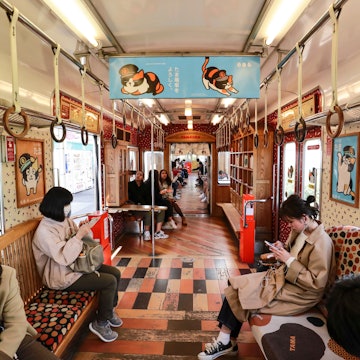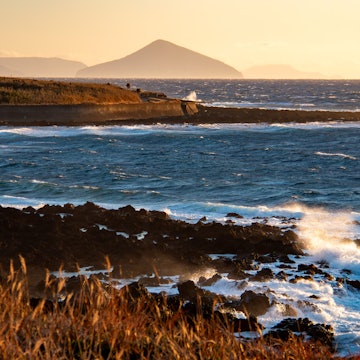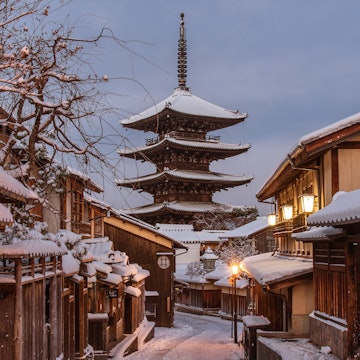

A tea ceremony in Kyoto. B.S.P.I./Getty Images
The beginnings of the Japanese tea ceremony as we know it today were developed in Kyoto sometime during the late 16th century. The English-language term "tea ceremony" is a bit misleading, and comes from Western observers perceiving the practice as ceremonial in nature; in Japanese, it's often referred to as sadō or chadō, literally "way of tea." While it’s not a ritual, there’s plenty to enjoy and appreciate about this cultural activity, such as the wabi-sabi (loosely translated as beauty in imperfection) aesthetics of the tearoom, the beauty of the utensils, and the multisensory experience of tea-making.
Many places in Kyoto, from temples to teahouses, offer tea ceremony experiences. Some are less formal than others. Some offer kimono rentals so guests can drink tea in traditional garb. Some include only usucha (thin green tea), while others let you taste the more formal koicha (thick tea) as well.
Perhaps one of the most common misconceptions about Japanese tea ceremonies is that they're dreadfully stiff and formal – they can be, but they don't have to be. A good host will always make allowances for their guests, especially first-timers, to the tearoom. As tea master Michael Sōzui – of the Urasenke school of chadō – says of this activity, the host makes a bowl of tea, and the guest drinks the tea. Everything else is detail.

When should I do tea ceremony?
The short answer: Anytime you like.
The longer answer: Because tea ceremony often celebrates the changing of the seasons, no two gatherings will be identical, and how it is conducted varies throughout the year. It also depends on whether you want to attend a chakai (an informal tea gathering lasting 30 minutes to an hour) or a chaji (a formal tea gathering lasting up to four hours).
For example, a summer tea ceremony is better early in the morning when it is cooler. Less common but equally atmospheric is one held in the evening by candlelight. During warmer weather, the fire will be prepared in the corner of the tearoom further away from the guests; while in winter, the fire is in the center of the room. Flowers are always seasonal; the vase in the alcove may hold camellia flowers in spring, or Chinese bellflowers in autumn. Even the tea bowls used will vary depending on the time of year.
In other words, tea ceremony is worth doing at any time of the year as there’s something to enjoy in every season.

How much time should I spend doing tea ceremony?
The average group session, where the host makes a bowl of tea and introduces the culture of tea ceremony to guests, is usually around 45 minutes to an hour. This is generally representative of a chakai, or informal tea gathering. If the experience includes kimono rental or a tea/sweet-making session, it may run up to two hours.
A chaji, or formal tea gathering, will last around three to four hours. This includes watching the host building the fire from scratch, eating a multicourse tea kaiseki meal, examining the tea utensils, and enjoying several bowls of tea in two different styles. It might seem long, but time does fly by in a well-executed chaji!

Top tea ceremony things to do in Kyoto
Try tea ceremony while dressed in kimono
In addition to explaining the intricacies of tea ceremony, many providers offer the option to wear kimono for a more immersive experience. It certainly makes you wonder how tea practitioners manage to move so gracefully on their knees while in kimono! Some places that offer this option include: Camellia in Ninenzaka, Nagomi in Ninenzaka, and Tea Ceremony KOTO near the Golden Pavilion.
Meet real geiko (geisha) over a bowl of tea
If you’re looking for a special spin on a tea ceremony experience, try attending one led by a practicing geisha (known as geiko in Kyoto) or maiko (apprentice geiko). You can book a session at Maikoya, where a geiko or maiko will not only demonstrate and explain a tea ceremony, but also teach you how to prepare matcha, offer insights into geiko culture, and perform a dance. This is perfect if you want to meet one of these hard-working artisans while keeping interactions respectful.

Meditate and make a bowl of matcha at a Zen temple
Zen Buddhist monks centuries ago once used matcha as a meditation aid (it helped them stay awake during long sessions), so it’s only fitting that you can combine both. Shunko-in offers a Zen-focused version of a tea ceremony at its temple that’s considerably different from most others. It begins with tea preparation and a seated meditation session led by the head priest, followed by tea-drinking, more meditation, a short lecture, and a guided tour of the garden and prayer hall.
Experience a chaji, or full-length formal tea gathering
Chaji are exceptional even in the tea world, and it is rare for non-tea practitioners to be invited to one. Most Japanese people will never have been to one. As such, some tea masters have begun offering chaji experiences so that those outside the tea world can gain an insight into this special style of event. No two are alike, and the styles of chaji vary tremendously depending on the provider. Bikouen’s chaji is an elegant, pared-back affair that includes shōjin-ryōri – Buddhist vegetarian cuisine, served especially at temple lodgings – while the chaji conducted by Michael Sōzui at Kanjoan is an intimate experience tailored to each group.

My favourite thing about tea ceremony
Simply put, it’s the joy of experiencing something beautiful. I adore the attention to detail in every single aspect of tea ceremony and how the entire atmosphere engages your senses. It forces you to be completely present for the moment. I love the mental break from technology in the tea room.
At the risk of sounding like a total snob, I also love the tea sweets and the high-quality matcha used in tea ceremony. Proper matcha can be a little bitter if you’re accustomed to matcha lattes, but it’s hard to go back to chain stores once you acquire a taste for it.
How much money do I need for tea ceremony and do I need to reserve?
Tea ceremony isn’t cheap, but it isn’t ruinously expensive either. A simple 45-minute introduction to the practice starts at around ¥3000 (US$20) per person. Expect higher prices for similar but private group sessions, around ¥15,000 to ¥20,000 (US$100 to US$133) or more. At the upper end of the spectrum, more elaborate tea ceremony experiences like chaji can cost around ¥50,000 to ¥75,000 ($332 to $500) per person.
Most tea ceremony experiences are by advance reservation only. (Walk-ins are rare.) Popular venues such as Camellia can book out several months in advance, particularly during spring and autumn, so it’s best to plan early. As these experiences can be reserved online, payment with a credit card is usually acceptable. However, a small minority of providers may still ask for payment via cash or bank transfer.
Here are some indicative prices, which represent the average cost for one participant.
40–70-minute tea ceremony, group session: ¥3000–5000 (US$20–33)
90–120-minute tea ceremony with kimono rental: ¥7000–13,000 (US$46–86)
Private chaji session: ¥15,000–80,000 (US$100–531)
90-minute meditation and tea ceremony: ¥19,800/person (US$132)

Do I have to sit on the floor?
While traditional etiquette encourages guests to sit on the floor seiza-style, with legs folded under them, most providers are reasonably flexible and accommodating. When making your booking, ask about the possibility of using extra cushions or sitting on a low stool.
Alternatively, Canadian tea master Randy Soen Channell conducts tea ceremonies in a more modern Ryurei style (created in 1872) where guests can sit on Western-style chairs instead of on tatami mats – ideal for those who find floor seating uncomfortable. Tea shouldn’t be torture, so find a provider who can work with your needs.
Tips for first-timers
Wear slip-on shoes as you’ll be entering a tatami mat-lined room indoors. Socks are highly encouraged.
Wear clothes you’ll be comfortable in while seated on the floor. It’s best to avoid overly-casual clothing, such as short skirts and shorts.
Most tea experiences are not child-friendly, as they require being quiet and sitting still for extended periods of time. If you're traveling with kids, look for providers who offer sessions specifically tailored for families with young children.
Drink your matcha as soon as you receive it — don’t wait for other guests! Whisked matcha is a suspension, and the powder will separate from the water if you let it sit. It’s best when freshly whisked and still warm.
















